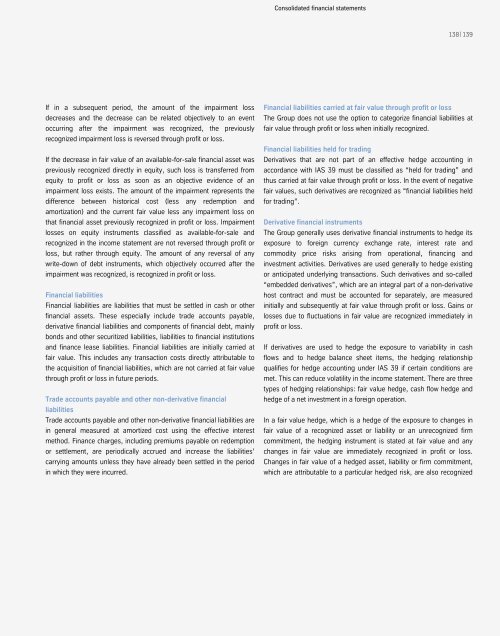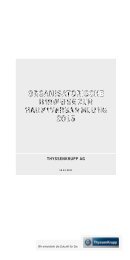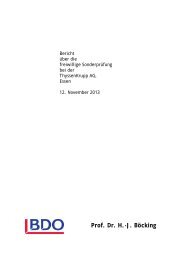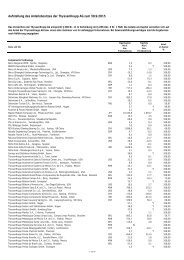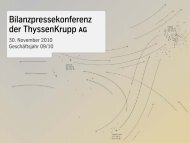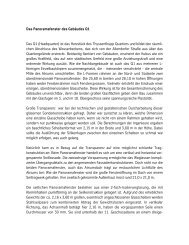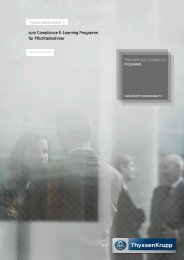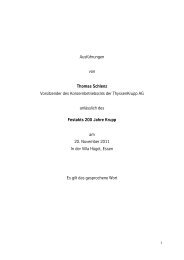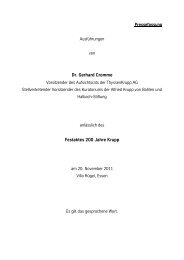PDF (10.9MB) - ThyssenKrupp AG
PDF (10.9MB) - ThyssenKrupp AG
PDF (10.9MB) - ThyssenKrupp AG
Create successful ePaper yourself
Turn your PDF publications into a flip-book with our unique Google optimized e-Paper software.
3.6 Consolidated financial statements Notes to the consolidated financial statements<br />
If in a subsequent period, the amount of the impairment loss<br />
decreases and the decrease can be related objectively to an event<br />
occurring after the impairment was recognized, the previously<br />
recognized impairment loss is reversed through profit or loss.<br />
If the decrease in fair value of an available-for-sale financial asset was<br />
previously recognized directly in equity, such loss is transferred from<br />
equity to profit or loss as soon as an objective evidence of an<br />
impairment loss exists. The amount of the impairment represents the<br />
difference between historical cost (less any redemption and<br />
amortization) and the current fair value less any impairment loss on<br />
that financial asset previously recognized in profit or loss. Impairment<br />
losses on equity instruments classified as available-for-sale and<br />
recognized in the income statement are not reversed through profit or<br />
loss, but rather through equity. The amount of any reversal of any<br />
write-down of debt instruments, which objectively occurred after the<br />
impairment was recognized, is recognized in profit or loss.<br />
Financial liabilities<br />
Financial liabilities are liabilities that must be settled in cash or other<br />
financial assets. These especially include trade accounts payable,<br />
derivative financial liabilities and components of financial debt, mainly<br />
bonds and other securitized liabilities, liabilities to financial institutions<br />
and finance lease liabilities. Financial liabilities are initially carried at<br />
fair value. This includes any transaction costs directly attributable to<br />
the acquisition of financial liabilities, which are not carried at fair value<br />
through profit or loss in future periods.<br />
Trade accounts payable and other non-derivative financial<br />
liabilities<br />
Trade accounts payable and other non-derivative financial liabilities are<br />
in general measured at amortized cost using the effective interest<br />
method. Finance charges, including premiums payable on redemption<br />
or settlement, are periodically accrued and increase the liabilities’<br />
carrying amounts unless they have already been settled in the period<br />
in which they were incurred.<br />
Consolidated financial statements<br />
138 | 139<br />
Financial liabilities carried at fair value through profit or loss<br />
The Group does not use the option to categorize financial liabilities at<br />
fair value through profit or loss when initially recognized.<br />
Financial liabilities held for trading<br />
Derivatives that are not part of an effective hedge accounting in<br />
accordance with IAS 39 must be classified as “held for trading” and<br />
thus carried at fair value through profit or loss. In the event of negative<br />
fair values, such derivatives are recognized as “financial liabilities held<br />
for trading”.<br />
Derivative financial instruments<br />
The Group generally uses derivative financial instruments to hedge its<br />
exposure to foreign currency exchange rate, interest rate and<br />
commodity price risks arising from operational, financing and<br />
investment activities. Derivatives are used generally to hedge existing<br />
or anticipated underlying transactions. Such derivatives and so-called<br />
“embedded derivatives”, which are an integral part of a non-derivative<br />
host contract and must be accounted for separately, are measured<br />
initially and subsequently at fair value through profit or loss. Gains or<br />
losses due to fluctuations in fair value are recognized immediately in<br />
profit or loss.<br />
If derivatives are used to hedge the exposure to variability in cash<br />
flows and to hedge balance sheet items, the hedging relationship<br />
qualifies for hedge accounting under IAS 39 if certain conditions are<br />
met. This can reduce volatility in the income statement. There are three<br />
types of hedging relationships: fair value hedge, cash flow hedge and<br />
hedge of a net investment in a foreign operation.<br />
In a fair value hedge, which is a hedge of the exposure to changes in<br />
fair value of a recognized asset or liability or an unrecognized firm<br />
commitment, the hedging instrument is stated at fair value and any<br />
changes in fair value are immediately recognized in profit or loss.<br />
Changes in fair value of a hedged asset, liability or firm commitment,<br />
which are attributable to a particular hedged risk, are also recognized


